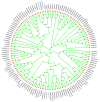The Discovery of Potential Repellent Compounds for Zeugodacus cucuribitae (Coquillett) from Six Non-Favored Hosts
- PMID: 40724809
- PMCID: PMC12295180
- DOI: 10.3390/ijms26146556
The Discovery of Potential Repellent Compounds for Zeugodacus cucuribitae (Coquillett) from Six Non-Favored Hosts
Abstract
Zeugodacus cucuribitae (Coquillett) (Z. cucuribitae) is a global extremely invasive quarantine pest which has a wide host range of fruits and vegetables. At present, there are a few control measures for Z. cucuribitae, and deltamethrin and avermectin are commonly used. Among the hosts of Z. cucuribitae, Luffa acutangular, Luffa cylindrica, Sechium edule, Brassica oleracea var. botrytis, Musa nana, and Fragaria × ananassa are non-favored hosts. However, it is still not clear why these hosts are non-favored and whether there are any repellent components of Z. cucuribitae in these hosts. In this study, the components of these six hosts were collected from the literature, and the genes of odor and chemical sensation were determined from the genome of Z. cucuribitae. After the potential relationships between these components and genes were determined by molecular docking methods, the KEGG and GO enrichment analysis of these genes was conducted, and a complex network of genes vs. components vs. Kegg pathway vs. GO terms was constructed and used to select the key components for experiments. The results show that oleanolic acid (1 mg/mL, 0.1 mg/mL, and 0.01 mg/mL), rotenone (1 mg/mL, 0.1 mg/mL, and 0.01 mg/mL), and beta-caryophyllene oxide (1 mg/mL, 0.1 mg/mL, and 0.01 mg/mL) had a significant repellent effect on Z. cucuribitae, and three components, rotenone (1 mg/mL and 0.1 mg/mL), echinocystic acid (1 mg/mL, 0.1 mg/mL, and 0.01 mg/mL), and beta-caryophyllene oxide (1 mg/mL, and 0.1 mg/mL) had significant stomach toxicity in Z. cucuribitae. Furthermore, a complex signaling pathway was built and used to predict the effect of these components on Z. cucuribitae. These components probably play roles in the neuroactive ligand-receptor interaction (ko04080) and calcium signaling (ko04020) pathways. This study provides a reference for the prevention and control of Z. cucuribitae and a scientific reference for the rapid screening and development of new pest control drugs.
Keywords: Zeugodacus cucuribitae (Coquillett); insect repellent; molecular docking; network pharmacology; olfactory genes.
Conflict of interest statement
The authors declare no conflicts of interest.
Figures






Similar articles
-
The Black Book of Psychotropic Dosing and Monitoring.Psychopharmacol Bull. 2024 Jul 8;54(3):8-59. Psychopharmacol Bull. 2024. PMID: 38993656 Free PMC article. Review.
-
Home treatment for mental health problems: a systematic review.Health Technol Assess. 2001;5(15):1-139. doi: 10.3310/hta5150. Health Technol Assess. 2001. PMID: 11532236
-
Drugs for preventing postoperative nausea and vomiting in adults after general anaesthesia: a network meta-analysis.Cochrane Database Syst Rev. 2020 Oct 19;10(10):CD012859. doi: 10.1002/14651858.CD012859.pub2. Cochrane Database Syst Rev. 2020. PMID: 33075160 Free PMC article.
-
The effect of sample site and collection procedure on identification of SARS-CoV-2 infection.Cochrane Database Syst Rev. 2024 Dec 16;12(12):CD014780. doi: 10.1002/14651858.CD014780. Cochrane Database Syst Rev. 2024. PMID: 39679851 Free PMC article.
-
A rapid and systematic review of the clinical effectiveness and cost-effectiveness of paclitaxel, docetaxel, gemcitabine and vinorelbine in non-small-cell lung cancer.Health Technol Assess. 2001;5(32):1-195. doi: 10.3310/hta5320. Health Technol Assess. 2001. PMID: 12065068
References
-
- De Meyer M., Delatte H., Mwatawala M., Quilici S., Vayssières J.F., Virgilio M. A Review of the Current Knowledge on Zeugodacus Cucurbitae (Coquillett) (Diptera, Tephritidae) in Africa, with a List of Species Included in Zeugodacus. Zookeys. 2015;540:539–557. doi: 10.3897/zookeys.540.9672. - DOI - PMC - PubMed
-
- Dorla E., Gauvin-Bialecki A., Deuscher Z., Allibert A., Grondin I., Deguine J.P., Laurent P. Insecticidal Activity of the Leaf Essential Oil of Peperomia Borbonensis Miq. (Piperaceae) and Its Major Components against the Melon Fly Bactrocera Cucurbitae (Diptera: Tephri-tidae) Chem. Biodivers. 2017;14:e1600493. doi: 10.1002/cbdv.201600493. - DOI - PubMed
MeSH terms
Substances
Grants and funding
LinkOut - more resources
Full Text Sources

